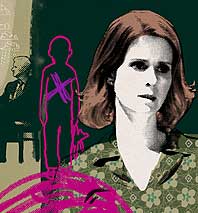
David Lindsay-Abaire’s Rabbit Hole is the sort of quality play I abhor. Its writing, acting, and directing exude proficiency. Often it’s funny when it wants to be funny and sad when it wants to be sad. So it may be worth seeing, if you’re into that sort of thing.
But why are you into that sort of thing? Rabbit Hole is a good story decently told, but you can find those more cheaply at a cineplex (top price here: $80) and more comfortably on your couch. I don’t mean to pick on Lindsay-Abaire or discount the things his play does well. Still, Rabbit Hole belongs to a swollen class of plays that have all sorts of storytelling virtues but no particular theatrical virtues. You might as well watch TV.
If you object to that argument, you’re not the first. The friend I took to the show—who was quite moved—insisted it had plenty of theatrical appeal. The story traces a young couple’s struggle after their 4-year-old son dies in an auto accident; when we see these suffering people up close and in three dimensions (my friend maintains), we are uniquely affected by their useless search for comfort. It helps that the grieving mother is played by Cynthia Nixon: Radiating reasonableness and integrity, she is always sympathetic, if rarely devastating.
Part of the problem is the form, as a two-act play turns out to be an unsatisfying way to tell this story. There are a few minutes of banter, then a few minutes of conflict—then it starts over. Meanwhile, all sorts of emotionally loaded business, like Becca’s walking past her son’s school during recess, keeps transpiring out of sight. Glimpses of these and other fraught moments might lend the play a dramatic punch Lindsay-Abaire’s onstage recaps don’t.
But the playwright has left himself no other options. He has told this story as a work of domestic realism, the least theatrical of all theatrical forms. For more than a century, that’s been the dominant mode of American drama, in which writer, director, and designers go to immense lengths to re-create real life as precisely as possible onstage. In Rabbit Hole, when Becca’s sister visits to inform her of her dramaturgically handy pregnancy and Becca rinses some dishes, the kitchen sink really works. (Onstage plumbing always cracks me up.) As the story skips around the house, scenic wizard John Lee Beatty needs not one but a pair of revolves to keep up the pursuit of verisimilitude. Between scenes, the two sides of the stage perform matching pirouettes.
Beyond all this lumbering about, the real disappointment of the play—of so many plays—is how little advantage it takes of all the peculiar, wonderful things the stage can do. Though his play deals with grief that can find no expression in words, he never has the characters address us directly. There’s neither poetry nor spectacle here, nothing to engage the audience’s imagination or to involve us in the action. (In Doubt, the accused priest was scary not because we could see him but because, in his sermons, he could see us.)
Some realistic plays still prove transcendent, of course. But the most affecting and memorable shows in my experience have tended to be the overtly theatrical ones, stories that could only be told onstage, that justify live theater’s large prices and tiny seats—from John Doyle’s mind-altering, imagination-firing Sweeney Todd to plays by Caryl Churchill, Richard Greenberg, Charles Mee, and especially Tony Kushner, whose magnificent Angels in America —even buttressed by the collective talent of Mike Nichols and some of the best actors alive—didn’t work on HBO. With its stage magic and soliloquies, it’s a story that can only be told in front of an actively engaged live audience. Seeing Rabbit Hole, by contrast, consists of two hours of sitting in the dark, watching people talk. At least the movies give you popcorn.
Rabbit Hole
By David Lindsay-Abaire. Biltmore Theatre.